Abstract
The Medical Poem (“Al-Urjuzah Fi Al-Tibb”) of Ibn Sina (Avicenna, 980-1037), is the subject of this primary-source study evaluating its scientific value, poetics and pedagogical significance as well as assessing its role in the transmission of medical knowledge to Medieval Europe. In addition to one original manuscript and two modern editions, the English translation by Krueger was also studied. Ibn Sina's poem on medicine consisting of meticulously classified 1326 verses, can be considered as a poetic summary of his encyclopedic textbook: The Canon of Medicine; hence its popularity in the East then the West as a tool in the process of transmitting medical knowledge from master to student. Since first translated by Gerard of Cremona (1114-1187) in the middle of the 12th century, the Latinized poem was frequently published in Medieval Europe either independently or combined with the Latinized Canon of Medicine or with the Articella; the famous collection of Greco-Roman and Latinized Arabian medical treatises in use in the universities of Salerno, Montpelier, Bologna and Paris up to the 17th century. The study of the Krueger's English edition revealed few places where the full meanings of the original Arabic text were not conveyed. A list of those places is given together with the suggested corrections.
Keywords: Arabic medical poetry, history of medical education, history of medieval Islamic medicine, Latin translations of Islamic medicine, medieval medical poetry
INTRODUCTION
With the increased interest in literary studies and the revival of various natural sciences that occurred in the Medieval Islamic world in the 8th century, a new theme of Arabic poetry flourished with the appearance of a tradition of didactic poems composed by scholars to be used in educating and training their students. Not only numerous medical treatises were rendered into verse to help students memorize basic concepts but also essays on other topics such as Quranic studies, Arabic grammar, history, oceanography, navigation, astronomy and even mathematics.
The “Al-Urjuzah Fi Al-Tibb”, the Medical Poem of Ibn Sina, known in Latin as Avicenna, (980-1037) is the most notable example of this genre and is the subject of this study evaluating its poetics and pedagogical significance as well as its role in the transmission of medical knowledge to Medieval Europe.
MATERIALS AND METHODS
In addition to an original manuscript [Figure 1] from the Al-Azhar University's Collection in Cairo,[1] the following primary sources were also studied:
Figure 1.
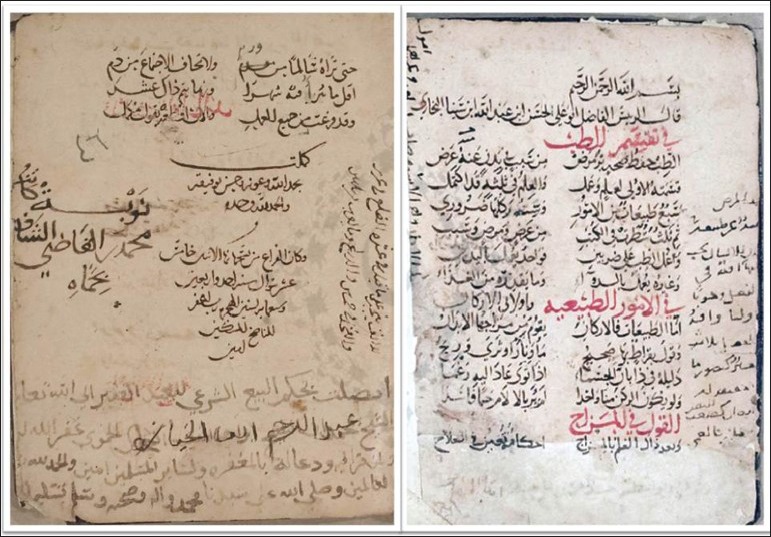
The first and last pages of an original manuscript of Ibn Sina's Medical Poem[1]
A nineteenth-century Lucknow edition by Abdel-Majeed[2] reprinted again by Khan[3] in 1845.
A 20th-century Paris edition by Jahier and Noureddine including, with the original Arabic text, a French Translation.[4] The verses, in this edition, are sequentially numbered from the beginning of the poem to the end making a total of 1326 verses and providing the individual numbers for verses quoted in the current study.
A twentieth century English translation by Krueger[5] based mainly on the above mentioned French translation and keeping the same sequence and the total number of verses. Unless otherwise mentioned, this translation is the source for all the quotations in this article.
A recent Arabic edition by Al-Baba[6] in Aleppo in1984 based on three original manuscripts of the Urjuzah and published together with three other medical works of Ibn Sina. Like the Paris edition, the verses, here, are also sequentially numbered but with a total excess of 11 verses 8 of which are in the Preface section.
All the above-mentioned texts of Ibn Sina's medical poem were studied and compared in order to assess the following points:
The poet, poem and poetics
The poem's content
Evidence of its influence both in the Medieval Islamic World and the Medieval Europe.
Poet, poem and poetics
The name “urjuzah” given to Arabic didactic poems indicates two characteristic features. Firstly; poems in that genre is usually composed on the Rajaz meter whose pattern of syllabic repetitions produces a jingling sound that is particularly easy to remember. Secondly; contrary to the mono-rhymic arrangement of standard poems, the rhyme of the first verse in an urjuzah is not followed in the remaining verses of the poem. However, there is a constant similar rhyming of the two hemistiches in each verse.
Ibn Sina was, himself, a talented and prolific poet. Ibn Abi-Usaybia, in his celebrated Classes of Physicians narrated 20 excerpts from Ibn Sina's brilliant poetry covering different genres and following various meters. He also stated that Ibn Sina at the age of 17 authored a book on prosody titled ‘Mo’tassam Al-Shuara Fi Al-Arood’ (The Prosody Mainstay for Poets).[7]
As documented by Qattaya, Ibn Sina composed several other medical Urjuzahs, one on anatomy, on health preservation during the four seasons, on tried medicaments and on clinical evidence derived from pulse and urine. However, his Urjuza Fi Al-Tibb the subject of this study is the longest and most famous of them.[8]
Poem's content
The preface
All the Lucknow, Paris and Aleppo editions as well as the English translation include Ibn Sina's preface to his poem both in prose and then in verse. The statements in the prose preface reveal that it was often in Ibn Sina's time that poet physicians composed medical urjuzas and epitomes. Furthermore, his criticism of the medical profession in a one place for lacking in “lecture meetings and in discussions in hospitals and schools” indicates that those educational measures were commonly practiced then. Ibn Sina described his poem as “dealing with all parts of medicine, drawn up in a very simple style, in convenient versification so that it may be easy, less difficult to understand”.[9]
Next to the eloquent prose preface, Ibn Sina’ poem started with 12 verses praising and thanking The Creator, God All-Mighty All-Knowing for granting mankind the blessing of reasoning which enabled our minds to learn, discover and see the invisible. The details of those 12 verses clearly show the unity of science, religious belief and spiritual knowledge in the minds of Medieval Islamic scholars.
In this section, Krueger translated the verse No 12 as: “preoccupying themselves with the body-granting to it the rightful mirth”.[10] However, as the word “body” (al-jasad) was not mentioned by Ibn Sina at all in this section and considering the meaning of the words “al-dhat” and “al-awkad”, as well as keeping in line with the textual meaning of the preceding verses 9, 10 and 11, the following different translation is hereby presented:
“Because they were preoccupied with their inner soul, granting to it the surest of pleasures”.
The definition of medicine
Under this title in the poem, the definition of medicine was amazingly expressed in just one verse [Figure 2] translated by Krueger as: “Medicine is the preservation of health and the cure of disease which arises from conscious causes which exist within the body”.[11] In difference with Krueger, considering the meaning of the words “anhu” and “arad”, another translation is hereby presented: “Medicine is to preserve health and cure diseases arising from causes affecting the body and producing symptoms”. This new translation is also supported by one of the verses that followed in the section on the “Classification of Medicine” (verse No. 20) in which the same word “arad” is translated by Krueger as “symptom”.[12]
Figure 2.
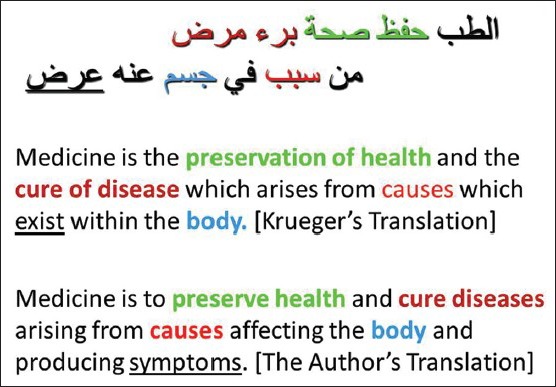
The verse in Ibn Sina's poem defining ‘Medicine’ in the original Arabic (top), as translated by Krueger (middle) and by the author (bottom)
Therefore, in one single verse, Ibn Sina managed to give a brilliant comprehensive definition of medicine able to include, in today's language, the broad outlines of a medical curriculum:
“Hifz Sihhatin” is preserving health and refers to preventive medicine.
“Buru Marad” is the treatment of an illness and refers to therapeutic medicine.
“Min Sababin” means due to a cause thus referring to the study of etiology, pathology, bacteriology and parasitology.
“Fi Jismin”: this refers to the study of the normal body
“Anhu Arad”: means: ‘resulting from that illness are symptoms’. This refers to clinical medicine.
The verse, also, resonates the prime emphasis laid on preventive medicine during the medieval Islamic era; “Hifz Al Sihha”, the maintaining of health is always mentioned first, by the scholars of that era, before the treatment of illness. Thus, this precedence given to the preservation of health in this verse is not dictated by a rhymic necessity as the same sequence is also stated by Ibn Sina in his encyclopedic book Al Qanun Fi Al-Tibb; the Canon of Medicine.[13,14] This represents a continuation of the primary attention given to the preservation of health and prevention of disease a philosophy derived, according to Peneloppe Johnstone[15] from the medical guidance of Prophet Muhammed. A similar definition of medicine was given by Al-Razi (865-925) about a 100 years earlier and followed by later scholars such as Al-Zahrawi (930-1013) [Figure 3] and others.
Figure 3.
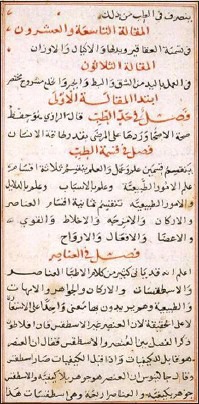
A page from an original manuscript of Al-Zahrawi's book Al-Tasrif showing the beginning of the first Maqala (treatise, chapter) starting with a quotation of Al-Razi's definition of medicine: “medicine is preserving health unto healthy individuals and returning it to the sick within the limits of human abilities”. Source: Manuscript No. 4009, courtesy of Chester Beatty Library: Dublin
The classification of medicine
The classification scheme used by Ibn Sina in the Urguza is typical of the well-documented skill in classifying knowledge and writing it down according to a plan and a rigorous orderly method, in an original, lucid, concise but precise and up-to-the point style, representing a salient feature of medical textbooks authored during the Islamic era as documented by many well-known scholars such as Charles Cumston and Lucien Leclerec who admired the clarity of medical textbooks written by Islamic Physicians when compared with those of ancient authors.[16,17] This is an extension of a general trend that spread among the leading medieval Islamic scholars in various disciplines, many of whom, as stated by Nasr.[18] and by Bakar,[19] devoted much of their intellectual energy to the subject of classification of sciences and knowledge as first demonstrated in the religious sciences, as can clearly be seen in their studies of jurisprudence and its source methodology, as well as in the documentation of Prophetic traditions.
Figure 4 is a simplified schematic outline of the classification plan of the first 212 verses of the Ibn Sina's medical poem. The poem first divided medicine into prevention and cure, then into theory and practice then each division was consequently further subdivided and arborized.
Figure 4.
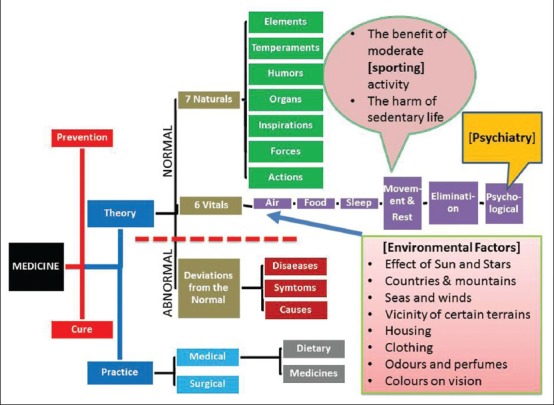
A simplified schematic outline of the classification of the first 212 verses of the Ibn Sina's Medical poem dealing with the normal state of the body
The theory part includes what is known at that time about both the normal and the abnormal states of the human body. In the normal states seven natural factors and six vitals are mentioned. The section on the natural factors starts with the following two verses:
“The elements are the constitutive parts of the body.
The opinion of Hippocrates on the subject is accurate; there are four of them: water, fire, earth [and] air”.[20]
The verses indicate that Ibn Sina, like his predecessors in the Islamic era, first reviewed the literature of the scholars from the previous ancient civilizations and adopted therefrom what they thought was correct, acknowledging the source they quoted from or agreed with.
The humoral theory developed by Hippocrates and propagated by Galen was adopted and favoured by the Islamic scholars because it gave the most rational basis to the theory and practice of medicine available at that time.
The rest of this section continues discussing the theoretical basis of the seven natural and six vital factors that were thought, then, to lead to and control the normal state of a healthy body.
In line with his predecessor Al Razi and conforming to the Islamic teaching of exalting the soul, the mind and the body at the same time, Ibn Sina emphasized the importance of psychological factors in the preservation and restoration of health. In this section, while discussing the natural forces, he devoted five verses under the separate title of “Psychic Forces” or “Forces of the Soul”.[21] Moreover, he stated another four verses in the section on the vital factors titled in the original as “Al-Ahdath Al-Nafseyyah” (“Psychiatric Events”) but translated by Krueger as “Sensations”.[22] This was obvious, too, in the treatment section of the poem when he recommended good company and music in the management of convalescent persons.[23] He also emphasized the role of environmental factors and highlighted the benefit of moderate sporting activity besides warning against the harm of sedentary life.[24]
The above-mentioned section of the Ibn Sina's medical poem composed of 190 verses is equivalent to the physiology of our today's medicine and is followed by the section on the deviations from the normal in which Ibn Sina versified the description of different types of diseases and their causes in the light of the most rational knowledge available at his time that is to say a disturbed humoral balance [Figure 5]. In a highly detailed system of classification, extending from verse No 213 until the verse 305, he described different pathological changes due to different etiological factors including congenital anomalies and birth injuries.[25] That 93 verse-long section covered what we describe now-a-days as pathology and etiology. It is followed by the longest section in the poem; the section on: Symptoms.[26]
Figure 5.
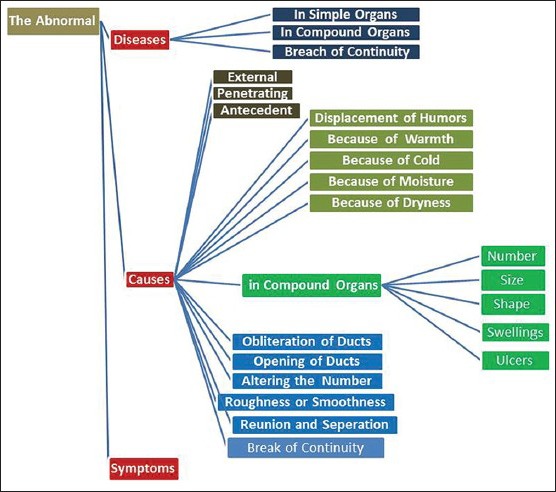
A simplified schematic outline of the classification of the section on deviations from the normal extending from verse No 213 until the verse 305
As explained by Ibn Sina in lucid verses in the beginning of this long section on Symptoms, the aim is to detect the site of the disease causing the disturbed function responsible for the symptoms. For that purpose, contrary to the medieval practice of relying only on looking at a sample of the patient's urine to make a diagnosis, Ibn Sina recommended using all the five special senses of the doctor in, first, examining the patient himself then looking later at everything eliminated from his body [Figure 6]. Here are the relevant verses 313-318 of the poem as translated by Krueger:
Figure 6.
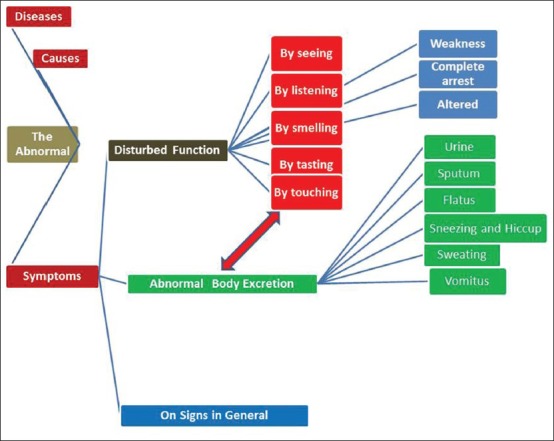
A simplified schematic outline of the classification of part of the section on Symptoms of diseases
“Symptoms are obtained through physical examination of the body at certain moments
There are some visible ones such as jaundice and edema
There are some perceptible to the ear such as gurgling of the abdomen in dropsy
The foul odour strikes at the sense of smell; for example that of purulent ulcers
There are some accessible to taste such as the acidity of the mouth
Touch recognizes certain ones; the firmness of cancer”.[27]
It is to be noted that, in the third verse of this excerpt (verse No. 315 of the poem), Krueger used the words “gurgling of the abdomen to translate the Arabic words “Khadkhadat Al Batn” which actually mean the ‘shaking of the abdomen’ by the examining physician to test for the presence of free fluid and air in a viscus or in a cavity. That physical sign described in this verse is the “succussion splash test” which remained as a part of today's clinical methods especially for those clinicians who still insist to use their clinical sense to reach a provisional diagnosis before resorting to imaging techniques.
Moreover the Arabic words “endal jass” mentioned in the excerpt's last verse (verse 318 of the poem) refer to the clinical method of palpation which enables the clinician to feel an underlying swelling. The use of palpation in clinical examination of patients was such a common knowledge in the medieval Islamic era to the extent that it was used by al Mutanabbi the tenth-century famous poet in a fascinating simile describing a lion walking gently and confidently in pride[28] as hereby translated:
“Gently stepping on the ground; out of his pride
As if it was a surgeon palpating a patient”.
In this section of the poem on Symptoms, Ibn Sina proceeds with further discussion of the diagnostic signs related to the past and present course of the illness as well as the prognostic signs that could help in anticipating its future outcome. He also discussed the general signs that help in diagnosing disease in each of the major organs of the body such as the brain the liver and the heart discussing clinico-pathological correlations to explain the arising symptoms and signs. He went into great details allocating 54 verses to discuss the diagnostic signs obtained from examining the patient's pulse, 21 verses for signs obtained from examining the sputum, 41 from the urine, 29 from the stools and 13 verses for signs obtained from examining the sweat. Moreover, Ibn Sina composed 264 verses to discuss at length the general and special prognostic signs that help in anticipating the course of the disease.
Hence, Ibn Sina devoted a total of 466 verses of his medical poem to the discussion of symptoms and signs of diseases. This reflects a continuation of the pioneering development made by Al-Razi in establishing clinical medicine and differential diagnosis[29,30] and is in agreement with Cumston who described the Arabian physicians as keen observers who excelled in diagnosis and prognosis with their description of symptoms showing a precision and originality that could be only obtained by direct study of the disease.[31]
With the end of the theory part of the poem, comes the beginning of second part devoted to medical practice but starting, as noted before, with preventive medicine; the art of preserving health through dietary regimens, hygienic housing and healthy environment. Among the topics discussed in this 209 verses-long section are the following:[32]
Dietary regimen according to seasons
Care for the traveler in the sea
Care for the traveler on land
Sporting care
Care for babies at first while in utero (antenatal care)
Natal and post natal care
The choice of the wet-nurse
Care for toddlers
Care for the convalescent
Care for the elderly.
In support of the previously-mentioned influence of the medical guidance of Prophet Muhammad on this prime attention given by Ibn Sina and his predecessors to the preservation of health are the following verses of his poem:
“If you wish to avoid illness, divide your tummy into 3 parts.
A third for respiration, a third for food and the rest for water”.[33]
Literally, the 2 verses are versification of the last part of the following authentic Prophetic tradition:
The Messenger of God said: “The son of Adam does not fill any vessel worse than his stomach. It is sufficient for the son of Adam to eat a few mouthfuls to keep him alive. If he must fill it, then one-third for his food, one-third for his drink and one-third for his breath”.[34]
Furthermore, in the regimen for the convalescent, Ibn Sina stated the following verses showing his care for the psychological state of the patients:
“Insist upon their quiet and rest, for their limbs are weak;
Try to lift their spirit through welcome words and pleasant company;
Give them sweet-scented perfumes and flowers;
Obtain happiness and music for them;
Spare them somber thoughts and fatigue”.[23]
This section of the poem on the preservation of health ended with the interesting topic of how to manage a patient who presented with prodromal or impending symptom of a disease.
Then came the second practical part: the 263 verses-long section that deals with the restoration of health to patients by the use of medicine and dietary regimens.[35] After clarifying the humoral theory principle of fighting an illness with medicines that have the power to counteract its causing factor, a section was then devoted to verses describing the various primary effects of different kinds of drugs such as: expelling humors through stools, dominating one's temperament, alleviating obstruction, astringents, liquidizing, causing flesh to bud and so on. Long lists of simple drugs for each therapeutic effect were then given.
Ibn Sina emphasized on the need to always start with simple drugs unless there is a reason to compliment more than one effect together. He gave practical principles for that purpose of preparing compound drugs.
Moreover, Ibn Sina discussed the degrees of strength of action of drugs and gave examples for each. Under the title of ‘Simple Drugs which Warm and Do Not Purge’ he started with the verse No 1043 translated by Krueger as follows:
“Beware that drugs which warm and have not been tried are”[36]
In difference with Krueger, the correct translation for that verse is:
“Beware that the warming drugs are such as those which was selected and tried”
This translation is in accord with the original text in the Azhar's manuscript and both the Lucknow and Paris editions [Figure 7]. The verses that followed completed a list of 77 of such tried simple drugs cited in 17 verses under that title. It is remarkable that despite the long, difficult and frequently foreign names of many of those tested drugs, the poetics of the verses went on finely without any irregularities in the characteristic music and syllabic sequence of the poem's meter.
Figure 7.
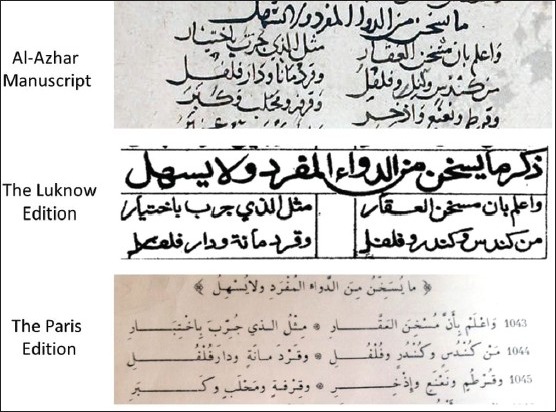
The title and first 3 verses of the section on ‘Simple Drugs Which Warm and Do Not Purge’ in the original manuscript and the 2 Lucknow editions
Furthermore, the statement of Ibn Sina that those examples of drugs were tested is in line of what he emphasized on in his Canon of Medicine stating that “The potency of drugs’ nature (Amzija) can be identified in two ways, one of them is analogy (qiyas) the other is by way of experimentation (tajribah). And let us start with discussing experimentation. So, we say that experimenting leads to confident knowledge of the potency of the medicine after taking into consideration certain conditions”.[37,38]
Following this 263 long section on medical treatment came the relatively shorter section on surgical treatment outlining, at first, surgical interventions on veins and arteries including venesection, cautery and ligation then on soft-tissues including incisions, drainage and excision giving a long list of examples in different parts of the body where excision may need to be done and finally on bones, fractures and dislocations.[39] As observed from Figure 8, this 75-verses section on surgical treatment, is the last and shortest whilst the section on symptoms and signs is the longest single subdivision occupying more than one third of the poem and thus highlighting the prime importance of clinical medicine to Ibn Sina.
Figure 8.

A schematic table showing the distribution and total number of verses of Ibn Sina's medical poem
The influence of the poem
As seen from the contents of the poem and the way it was classified, it is obvious that Ibn Sina did manage to abridge the principles of medical theory and medical practice of his time in a simple but elegant poetic style particularly helpful as a medium for medical education. This explains the popularity and wide spread of the poem both eastwards and westwards manifested by the appearance in the Islamic world of several commentaries and in medieval Europe of several Latin translations and prints, an interest in the poem that continued, in both places, till the 17th century.
Another influence of Ibn Sina's medical poem was the spreading popularity of composing didactic poems and utilizing it in medical education. In the Islamic world, several of those medical poems written after Ibn Sina are still extant but only in the form of unedited manuscripts.
Influence on medieval Europe
According to Sarton,[40] Latin translations of Ibn Sina's medical poem widely existed in medieval Europe since first translated, together with his Opus Magnus the Canon of Medicine by Gerard of Cremona in the 12th century. A century later, in addition to a Hebrew translation of the 2 books by Zarahiah Gracian and Nathan ba Meati, Armengaud de Blaise of Montpellier included a Latin translation of the Poem along with its commentary by Ibn Rushd. In 1527 Andreas Alpagus of Belluno added his effort by producing a revision of Gerard of Cremona's translation.
According to Krueger,[41] the only Latin translation of Ibn Sina's medical poem into verse was complete in the 16th century by Jean Faucher but this work was not printed until 1630. In 1649 appeared the last prose edition in Latin by Antonius Deusingius who was the first to include an approximation of the Arabic text of the poem's preface in verse.
Through the above mentioned Latin translations, the poem was made popular in Europe in the Middle Ages. The poem was published in several 16th-century printings, sometimes accompanied by a Latin translation of the commentary by Ibn Rushd (Averroes, 1125-1198). It continued to be printed and read through the 17th century.
The Latinized Avicenna's poem was printed in Europe either separately as in the editions shown in Figures 9a and b and Figure 10 or combined with the translated Canon of Medicine [Figure 11] or with the Articella [Figure 12]; the famous collection of Greco Roman and Latinized Arabian medical writings in use to supply the pedagogical need for brief statements of fundamental concepts in the curricula of universities of Salerno, Montpellier and Paris up to the 17th century. As stated by Sarton, the Latinized medical poem of Ibn Sina, known also as the Cantica Avicennae, became a perpetual part of that Articella.[42]
Figure 9.

Title page (a) and page 8 (b) of Cantica Avicennae in Use in Wittenberg School, published in 1562, courtesy of the Bayerische Staatbiblothek and the Munich DigitiZation Center of the Bavarian State Library
Figure 10.
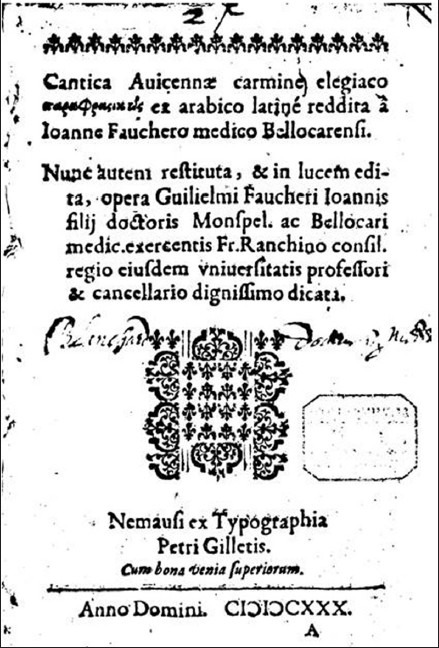
Front page of a Latin edition of Ibn Sina's medical poem translated into verse by Johannes Faucher in the 16th century and published by Gilletis 1630. Original is from the Bavarian State Library. Courtesy of Google e-books
Figure 11.
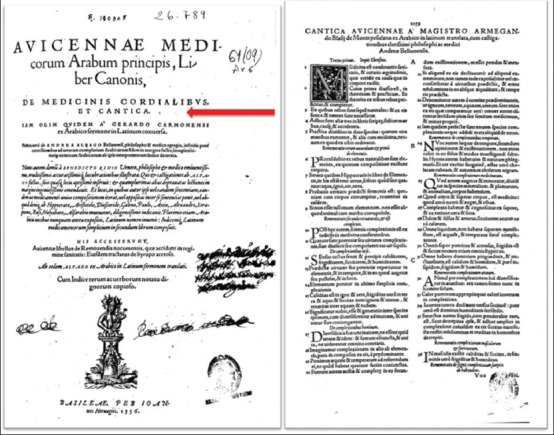
The title page of a Latin Edition of Ibn Sina's Canon of Medicine together with two of his other works; Cardiac Medicines and the Medical Poem (the Cantica Avicennae) published in 1562. The page on the right is page 1082; the beginning of the Cantica section. Courtesy of Google e-books
Figure 12.
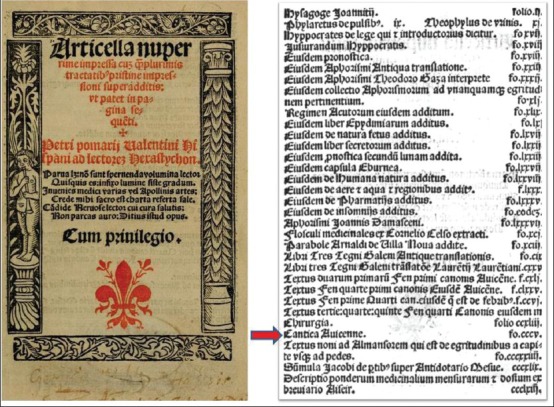
The title page of the Medieval European Latin textbook: The Articella. The page on the right shows a list of the authors and titles of their enclosed works including the medical poem of Ibn Sina (Cantica Avicennae); published in 1519 by Jacobum Myt in Impressum Lugduni and contains the same material included in the 1515 edition; original from: Francis A. Countway Library of Medicine; courtesy of Internet Archive
The Latinized medical poem of Ibn Sina was also the subject of several commentaries by Medieval European scholars such as the French Jacques Desparts of Tournay, Johannes Matheus Gradi, Thadea of Florence and Benedictus Rinius Venetus.[41]
Similarly, from the 12th century onward, Medieval Europe witnessed a rising trend of composing medical poems, particularly those related to preservation of health. As stated by Haskins,[43] following the flourishing of the Salerno school in the 12th century, the therapy of the Salernitan masters was popularized in the 362 lines poem, the Regimen Sanitatis Salernitanum [Figure 13]. However, according to him, a more adequate statement of the early teachings of Salerno appears in the various versified treaties of the 13th-century Gilles de Corbeil who came from the school of Salerno and Montpellier to Paris. His medical poems became didactic classics and were widely studied, copied and commented upon. This same trend to write medical poems continued into the eighteenth [Figure 14] and nineteenth centuries [Figure 15].
Figure 13.
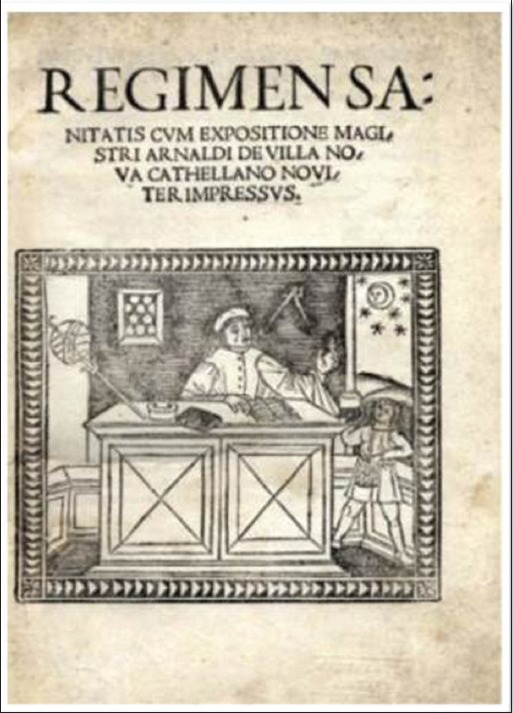
Title page from the first print edition (Venice, 1480) of the Regimen Sanitatis Salernitanum, with the commentary of Arnaldus de Villanova (the Catalan). Courtesy of the Wikimedia Commons
Figure 14.
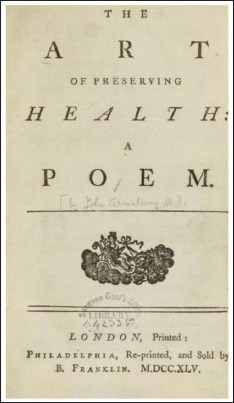
Title page of The Art of Preserving Health: A Poem by John Armstrong (in four books: Air, diet, exercise and passions), published by B. Franklin (London and Philadelphia) in 1745; original from US National Library of Medicine; courtesy of Internet Archive
Figure 15.
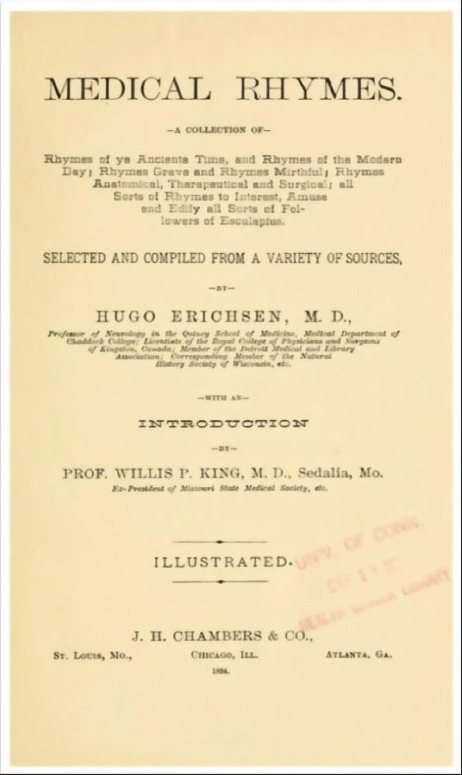
Title page of Medical Rhymes Selections Ancient and Modern’ by Hugo Erichsen published by J H Chambers and Co., Chicago in 1884; original from Yale University, Cushing Whitney Medical Library; courtesy of Internet Archive
Footnotes
Source of Support: Nil
Conflict of Interest: None
REFERENCES
- 1.Ibn Sina al-Husain Abddullah ibn Ali, Urjuza Fi Al-Tibb. Manuscript No. 840/95671/Tibb. Al Azhar Al-Sharif's Manuscript Online Collection. [Last accessed: 23.12.2013]. Available from: http://www.ahlalhdeeth.com/vb/showthread.php?t=70050 .
- 2.Ibn Sina al-Husain Abddullah ibn Ali. Al-Urjuzah Al Sinaeyyah Fi Al Masail Al Tibbeyyah. In: Abdel-Majeed, editor. Oorgoozeh or a Treatise on Medicine Originally Written by Abu Ali Ibn Sina. Lucknow: 1829. [Google Scholar]
- 3.Ibn Sina al-Husain Abddullah ibn Ali. Al Urjuzah Al Sinaeyyah. In: Khan MM, editor. Lucknow: Al Matba’ Al Hajari’ (The Hajari Press); 1845. [Google Scholar]
- 4.Paris: Société d’Edition “Les Belles Lettres”; 1956. Avicenne, Poème de la Médecine (The Medical Poem), Al-Husayn Ibn Abdullah Ibn Sina, Urguza Fi T-Tibb (Cantica Avicennae). Texte Arabe, Traduction Française, Traduction Latine du XIIIe siècle, avec Introductions, notes, et index. Etabli et présenté par (edited and translated by) Henri Jahier et Abdul_Kader Noureddine. [Google Scholar]
- 5.Krueger HC. Springfield, Illinois: Charles C Thomas Publishers; 1963. Avicenna's Poem on Medicine. [Google Scholar]
- 6.Al-Baba MZ. Aleppo: Institute of Arabic Scientific Heritage and Kuwait, The Arabic Manuscripts Institute; 1974. Min Muallafat Ibn Sina Al-Tibbiyyah (Some Medical Works of Ibn Sina) [Google Scholar]
- 7.Ibn Abi-Usaybia. Uyunul-Anba Fi-Tabaqat AI-Atibaa (The sources of the knowledge of classes of doctors) In: Reda N, editor. Beirut: Dar Maktabat al Hayat; 1965. pp. 437–59. [Google Scholar]
- 8.Qattaya S. Al-Arajeez Al Tibbeyyah. In: Salman Q, editor. Fi Al Turath Al-Tibbi Al-Arabi (On Arabic Medical Heritage). (Medical Poems/Ch. 18) Rabat: Publications of the Islamic Educational Scientific and Cultural Organization (ISECO); 2005. [Google Scholar]
- 9.Krueger, Op. Cit. (5), Preface in prose. :13–4. [Google Scholar]
- 10.Krueger, Op. Cit. (5), Preface in verse. :14–5. [Google Scholar]
- 11.Krueger, Op. Cit. (5), On the definition of the word ‘Medicine’. :15. [Google Scholar]
- 12.Krueger, Op. Cit. (5), On the subdivision of medicine. :15. [Google Scholar]
- 13.Vol. 1. Cairo: Bulaq; 1877. Ibn Sina al-Husain Abddullah ibn Ali (Avicenna). Al Qanun fi al tibb (The Canon of Medicine). Kitab No. 1; pp. 148–87. Undated Reprint by Dar Sadir. [Google Scholar]
- 14.Gruner OC, editor. Book One. New York: AMS Press; 1973. Ibn Sina al-Husain Abddullah ibn Ali (Avicenna). The Canon of Medicine of Avicenna; pp. 358–459. [Google Scholar]
- 15.Johnstone Penelope. Translator's introduction. In: Ibn Qayyim Al-Jawziyya., editor. Medicine of the Prophet. Penelope J, Translator. Cambridge: The Islamic Texts Society; 1989. pp. xxiii–xxxii. Reprinted twice 2001/2004. [Google Scholar]
- 16.Cumston CG. Islamic medicine. In: Cumston CG, editor. An Introduction to the History of Medicine from the Time of the Pharaohs to the End of the XVIII Century. London, (UK), New York: Kegan Paul, Trench, Trumbner and Co. Ltd., Alfred A Knopf; 1926. p. 191. [Google Scholar]
- 17.Leclerc L. I. Paris: Ernest Ledaux; 1876. Histoire de la medicine arabe (History of Arabian Medicine) pp. 91–2. [Google Scholar]
- 18.Nasr SH. Forward. In: Bakar O, editor. Classification of Knowledge in Islam. Cambridge: Islamic Texts Society; 1989. pp. xi–xv. Reprinted 2012. [Google Scholar]
- 19.Bakar O. Tawhid: The source of scientific spirit. In: Bakar O, editor. History and Philosophy of Islamic Science. 1st ed. Cambridge: Islamic Text Society; 1999. pp. 2–4. Reprinted 2012. [Google Scholar]
- 20.Krueger, Op. Cit. (5), On the natural components and first about the elements. :15. [Google Scholar]
- 21.Krueger, Op. Cit. (5), On the properties of the soul. :20–1. [Google Scholar]
- 22.Krueger, Op. Cit. (5), Sensations. :25–6. [Google Scholar]
- 23.Krueger, Op. Cit. (5), Directions for the convalescent. :61–2. [Google Scholar]
- 24.Krueger, Op. Cit. (5), Movement and rest. :24–5. [Google Scholar]
- 25.Krueger, Op. Cit. (5), On things which deviate from the normal state. :26–31. [Google Scholar]
- 26.Krueger, Op. Cit. (5), The section on symptoms. :31–53. [Google Scholar]
- 27.Krueger, Op. Cit. (5), On the varieties of symptoms obtained from the state of body. :31. [Google Scholar]
- 28.Al-Mutanabbi Ahmed Al-Husain. Diwan Abi El-Tayyib Al-Mutanabbi (Abu E-Tayyib Al Mutanabbi's Anthology) In: Abdel-Wahhab Azzam., editor. Cairo: Lajnat Al-Nashr Wa Al-Tarjamah Wa Al Taa’lif; p. 134. Committee for publishing, translation and authoring) Undated (editor's introduction dated 1944) [Google Scholar]
- 29.Abdel-Halim RE. Pediatric urology 1000 years ago. In: Rickham PP, editor. Progress in Pediatric Surgery. Vol. 20. Berlin, Heidelberg: Springer Verlag; 1986. pp. 256–64. [DOI] [PubMed] [Google Scholar]
- 30.Abdel-Halim RE. Clinical methods and team work: 1,000 years ago. Am J Surg. 2006;191:289–90. doi: 10.1016/j.amjsurg.2005.05.046. [DOI] [PubMed] [Google Scholar]
- 31.Cumston CG. Islamic medicine. In: Cumston CG, editor. An Introduction to the History of Medicine from the Time of the Pharaohs to the End of the XVIII Century. London, (UK), New York (NW): Kegan Paul, Trench, Trumbner and Co. Ltd., Alfred A Knopf; 1926. p. 192. [Google Scholar]
- 32.Krueger, Op. Cit. (5), On the conservation of health through diets and regimens. :53–63. [Google Scholar]
- 33.Krueger, Op. Cit. (5), On the beverage. :56. [Google Scholar]
- 34.Prophet Muhammad's Sayings (Hadith): Sunan Ibn Majah (Darussalam Edition with an English translation by Nasiruddin Al-Khattab): Kitabul Atteima (Chapters on Food): Ch. 50: Hadith 3349 [Google Scholar]
- 35.Krueger, Op. Cit. (5), To return health to patients with medicines and dietary regimens. :63–77. [Google Scholar]
- 36.Krueger, Op. Cit. (5), On simple drugs which warm and do not purge. :66. [Google Scholar]
- 37.Vol. 1. Cairo: Bulaq; 1877. Translated from: Ibn Sina (Avicenna) Kitab Al-Qanum Fi Al-Tibb (The Canon of Medicine), The second Maqalah, first Jumalah, the second Kitab; p. 224. Undated Reprint by Dar Sadir. [Google Scholar]
- 38.Abdel-Halim RE. Experimental medicine 1000 years ago. Urol Ann. 2011;3:55–61. doi: 10.4103/0974-7796.82168. [DOI] [PMC free article] [PubMed] [Google Scholar]
- 39.Krueger, Op. Cit. (5), Surgical practice. :77–81. [Google Scholar]
- 40.Sarton G. Baltimore, New York: Williams and Wilkins Company, Robert E. Krieger Publishing Co, Inc; 1927-1931, 1975. Introduction to the History of Science. Vol. II. Part II. Carnejie Institution of Washington; pp. 790–832. [Google Scholar]
- 41.Krueger, Op. Cit. (5), History of the poem on medicine. :9–10. [Google Scholar]
- 42.Sarton G. Baltimore, New York: Williams and Wilkins Company, Robert E. Krieger Publishing Co, Inc; 1927-1931, 1975. Introduction to the History of Science. Vol. I. Carnejie Institution of Washington; p. 611. [Google Scholar]
- 43.Haskins CHH. 8th ed. Cambridge, MA: Harvard University Press; 1971. The Twelfth Century Renaissance; pp. 322–3. [Google Scholar]


